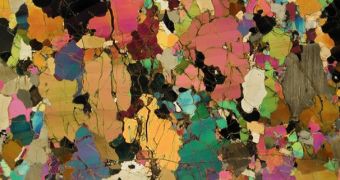For more than a century, geologists and planetary scientists have known about the existence of the Moho boundary, but the technological challenges associated with studying it prevented experts from gaining any new knowledge about it since then. Now, advancements allow us to investigate it in-depth.
This boundary, which was named after scientist Andrija Mohorovicic, occurs where the mantle sitting on top of Earth's core comes into contact with the crust. The crust is made up of tectonic plates, that it turn provide support for the planet's continents and oceans.
Back in 1909, Mohorovicic proved the existence of the boundary through analysis of seismic waves. Whenever they would go past a certain depth, their travel patterns would change, hinting that they ran into something that is inconsistent with the crust.
Since then, the model explaining Earth's interior has been established as true. The mantle is now defined as a layer of molten, semi-fluid rocks, that is stirred up by convection currents from the core.
Analyzing the Moho boundary could therefore provide new insight into how the planet was formed. However, getting to that location is a tremendously complex task. But that is in the past. We have the technology now to investigate this region in detail, and a study is already ongoing.
In the March 23 issue of the top journal Nature, two experts write about this research, which is being conducted by a Japanese ship and United States experts in a digging program, Universe Today reports.
University of Southampton National Oceanography Center expert Damon Teagle and French expert Benoît Ildefonse, from the Université Montpellier, are the authors of the Nature paper.
The two are co-chief scientists on the Integrated Ocean Drilling Program (IODP) Expedition 335, whose goal is “to obtain for the first time a section of the lower oceanic crust — the material lying just above the mantle.”
Between April and June 2011, the research vessel JOIDES Resolution will drill off the coast of Costa Rica, in a bid to retrieve and study material samples from that region.
“This site is in ocean crust that formed superfast – at more than 20 centimeters a year, much faster than any present day crust formation. That makes the upper crust there much thinner than elsewhere, so it is possible to reach the lower portions without having to drill very deep.” the two write.
“Three previous expeditions to Hole 1256D have drilled down to more than 1.5 kilometres below the sea floor, into the transition zone between dikes and gabbros,” they add in the study.
If the new expedition is successful, they experts could finally learn how oceanic ridges form new crust, how the lower crust is infused with magma from the mantle, and also how the lower oceanic crust contributes to underlying the magnetic anomalies discovered above Earth's oceans.
“Drilling to the mantle is the most challenging endeavour in the history of Earth science. It will provide a legacy of fundamental scientific knowledge, and inspiration and training for the next generation of geoscientists, engineers and technologists,” the experts conclude.

 14 DAY TRIAL //
14 DAY TRIAL //